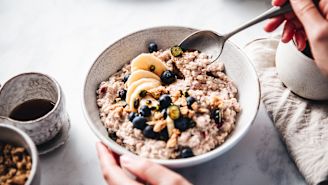Updated on October 28, 2024.
What if a single nutrient could:
- Lower your risk of death over time by 15 to 30 percent
- Lower cholesterol and blood pressure
- Help you maintain a healthy weight
- Reduce odds of developing diabetes, coronary heart disease, stroke, and certain cancers
According to a 2019 review published in The Lancet, eating enough fiber—the humble roughage that passes through you undigested—may do all that and more.
For the review, researchers looked at data from 185 prospective studies and 58 clinical trials with over 4,600 participants. A clear link emerged between how much fiber participants ate and their health. Those who took in between 25 and 29 grams a day showed the aforementioned benefits, but it was suggested that even higher intakes of fiber could produce healthier outcomes.
The benefits of fiber
There are two types of fiber, soluble and insoluble, with most plant-based foods containing some of each.
- Soluble fiber, which dissolves in water, prevents your body from fully absorbing dietary fat and cholesterol—which can help lower your “bad” cholesterol count. It also helps you digest food more slowly, which evens out blood sugar levels and keeps you feeling fuller, longer after eating a meal. This, in turn, can help you maintain a healthy weight.
- Insoluble fiber, on the other hand, feeds the bacteria that make up the bulk of your stool, which keeps things moving through your digestive system.
That’s not all. Fiber is found in nature in plant-based foods like fruits, vegetables, whole grains, nuts, seeds, and beans. As a result, fiber-rich foods often contain other beneficial nutrients, such as antioxidants and high-quality plant proteins.
"Fiber is a marker for good, healthy foods," says Robert Breakey, MD, head of IHA’s Family Medicine Division, part of Saint Joseph Mercy Health System in Ann Arbor, Michigan. "People who eat higher fiber do better because of what comes with it."
What’s more, while fiber travels through your body, it feeds your gut microbiome, home to trillions of microbial cells that nourish the colon, eliminate toxins, produce nutrients, balance hormones, lower inflammation, and support your immune system. If you don’t feed the microbiome properly, harmful bacteria grow, which can lead to a variety of illnesses. "We say a pregnant woman is eating for two," says Dr. Breakey, "but we should really think that each of us is eating for 30 trillion and one."
Fiber in your diet
The specific recommended daily intake of fiber depends on age, but ranges from 28 to 34 grams for adult men and 22 to 28 grams for adult women, according to the USDA’s Dietary Guidelines for Americans.
If you’re anything like the typical American, your fiber intake is around half that amount. That’s largely because processed foods make up more than half of our diets, according to a 2017 study published in Population Health Metrics. On average, the more heavily processed the food, the less fiber it contains.
If you’re averaging 15 grams of fiber a day, doubling that may seem daunting. Breakey advises starting slowly. "Even moving from the standard American diet to eating an extra serving of vegetables a day is progress," he says. "Every time you eat, it’s an opportunity to eat something better."
Adding too much fiber too quickly may cause a few unpleasant side effects like bloating, flatulence, or gas. If you experience any of these, add fiber-rich foods to your diet slowly and be sure to drink plenty of water.
Once your body gets used it, there’s no need to stop at 25 grams per day. The study published in The Lancet found that higher fiber intake is associated with greater protection against cardiovascular disease, type 2 diabetes, and colon cancer.
That doesn’t mean you should turn to a supplement. Breakey says that a supplement would only provide fiber from a single plant product. It won’t bring with it the nutrients you get from eating a variety of whole, fiber-rich foods. He advises reserving fiber supplements for the occasional bout of constipation, which is also a sign of a diet that’s too low in fiber. Once the supplement helps clear things out, aim to add more whole foods that are naturally high in fiber.
A high-fiber diet plan
Once you’ve started to add more unprocessed, plant-based foods to your diet, bringing your total over 25 grams a day isn’t as tough as it sounds. It can be as simple as starting to add a vegetable or fruit to every meal.
Here’s what a sample high-fiber day might look like:
Breakfast
- 1 cup shredded wheat cereal (with no sugar) (6.1 grams)
- Milk (0 grams)
- Coffee or tea (0 grams)
- 1/2 cup raspberries (4 grams)
TOTAL: 10.1 grams
Lunch
Sandwich made with:
- 2 slices 100% whole wheat or grain bread (3.8 grams)
- 1/2 cup avocado (4.9 grams)
- 1/2 cup tomato (1.1 grams)
- Cheese or turkey (0 grams)
- Banana (3.1 grams)
TOTAL: 12.9 grams
Snack
- 1 ounce almonds (3.5 grams)
- 1/2 cup dried apricots (4.5 grams)
TOTAL: 8 grams
Dinner
- Chicken (0 grams)
- 1 cup roasted broccoli (5.1 grams)
- 1 medium baked potato with skin (4 grams)
- Butter or sour cream (0 grams)
- 1 slice store-bought cherry pie (1 gram)
TOTAL: 10.1 grams
DAILY TOTAL: 41 grams
Once you achieve this level, continue to replace any food lacking fiber with whole plant-based alternatives to increase the amount of fiber you eat per day.
What about fruit?
Fruit is high in sugar, which you may have heard isn’t great for you. That’s not necessarily wrong—but added sugar found in processed foods is the big culprit. As you can see in the daily menu above, fruit can provide a significant amount of fiber to your day.
"The difference is that this is a natural form of sugar that comes along with everything else nature provided in that fruit," says Breakey. "The fiber, the complex carbohydrates, the proteins, even small amounts of fat—everything else in that strawberry or apple slows the digestion of the sugar and this makes whole fruits a very healthy food."
If you’re eating a low-carbohydrate diet…
Low-carb diets have become extremely popular over the last few decades as a way to lose weight. Because fiber is a type of carbohydrate, low-carb diets can make it difficult for you to eat enough fiber to reap its benefits—and nearly impossible if you are striving for a high fiber intake.
While these plans restrict your total carbohydrate intake (and may even banish whole grains and beans completely), they do allow you to eat certain vegetables and fruits, as well as nuts. Still, for those seeking to increase their fiber intake, these diets likely will not match your health goals. Weight loss, blood sugar control, and vitality may be better achieved with a healthy, whole foods-based diet.







